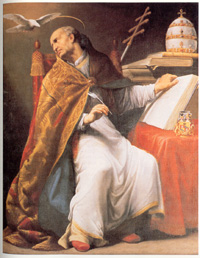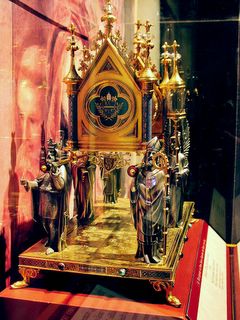Pope St. Gregory The Great

Pope St. Gregory the Great, Doctor of the Church
(Traditional Feast day: Sept. 3)
Life of the great Saint
Some saints actually were so great that it has become part of their name. Pope St. Gregory is one such saint. He is called "the Great." His family was also distinguished for its piety. Gregory's mother, Silvia is named as a saint in the Roman Martyrology. Besides his mother, two of Gregory's aunts, his father's sisters, have been canonized. Pope Felix III was Gregory's great-great-grandfather.
St. Gregory was born at Rome about the year 540. His father was a wealthy senator. Growing up Gregory loved to meditate on the Scriptures. He is said to have been devoted to God from his youth. Certainly he was helped in this from the religious atmosphere of his home. John the Deacon speaks of his education as being that of a saint among saints.
Given his father's position, it was only a matter of time before Gregory's public career began. At little more than thirty years old, Gregory held the important office of prefect of the city of Rome, the highest civil dignity in the city. After long prayer and some struggle Gregory decided to give up everything he had and become a monk. His Sicilian estates were given up to found six monasteries. His home on the Caelian Hill in Rome was converted into another one and placed under the patronage of St. Andrew. It was here that he lived as a monk for three years. Then the Pope ordained him as one of the seven deacons of Rome. He was sent to Constantinople on a Papal mission and for six years Gregory tried to live the monastic life there as far as circumstances permitted.
When recalled to Rome Gregory joyfully returned to the monastery of St. Andrew where he soon became abbot. The monastery grew famous under his energetic rule, producing many monks who won renown later. Gregory became the chief adviser and assistant of Pope Pelagius II, towards whom he seems to have acted very much in the capacity of secretary. When this Pope died Gregory was elected to be the successor unanimously by both the clergy and the people of Rome. Gregory resisted being made Pope, thought of running away, but was forcibly brought to St. Peter's and became Pope in 590.
Gregory was Pope for fourteen years, into which he crowded enough work to exhaust a lifetime, even though suffering from constant illness. He stilled tried to live monastic simplicity as Pope. He called himself the Servant of the Servants of God. By his many works of charity, Gregory emptied the treasury. This was because of his view that he was the administrator of the property of the poor, for whom he could never do enough. Almost the last act of his life was to send a warm winter cloak to a poor bishop who suffered from the cold. He was a great preacher and his sermons drew immense crowds. He was responsible for sending a group of missionaries to convert the "Angles" (England) led by St. Augustine of Canterbury. The miracles attributed to Gregory are very many.
If one can sum up a person titled "Great" we find Gregory as a trained Roman lawyer and administrator, a monk, a missionary, a preacher, above all a physician of souls and a leader of men. During his pontificate, he made it clear that the See of Peter was the one supreme, decisive authority in the Catholic Church. He is justly called the "Apostle of the English." His writings on the office of bishop became popular years later and his writing of the life of St. Benedict of Nursia brought popularity to this saint and the monastic life. (Source: Monks of Adoration; Photo: Crossroads Initiative)
St. Gregory the Great Chapel in St. Peter's Basilica
In the center of the altar are the mortal remains of Saint Gregory the Great (590-604), one of the greatest pontiffs in the history of the Church. He preferred to be known as the "servant of the servants of God", however the faithful also called him "Consul of God", "Savior of the Church", "Defender of Rome" (he defended the city against the Lombards whom he then converted to Christianity). He evangelized England by sending forty Benedictine monks as missionaries. Gregory's name is also linked to the musical forms he promoted, and even today Gregorian chant resounds with its pure melodies.
In the splendid mosaic above the altar, one of the most perfect in the entire basilica, the saint is depicted as showing the faithful a cloth stained with the blood of martyrs; he encourages them to remain faithful to Christ and to the commitments of Baptism.
To honor this great person, his tomb is surrounded by the four great Doctors of the Church: Saints Ambrose, Augustine, Athanasius and John Chrysostom, in the mosaic on the dome above the altar. (Source: St. Peter's Basilica website)

RELIQUARY OF ST. GREGORY THE GREAT
(Photo: American Society of The Defense of Tradition, Family and Property)
The Gregorian Chant
Pope St. Gregory the Great also inspired the Gregorian chant. He brought this chant to the West based on Eastern models of Byzantine chant. This music was traditionally sung by monks or other male clerics, and was used during religious services. It is the music of the Roman Rite of the Mass, also known as the Gregorian rite or Tridentine rite. Other rites of the mass, such as the Assyrian and the Coptic, use different melodies but share the unaccompanied and monophonic nature of the Gregorian, which allude to a common source.
In honor of Our Lady on this first Saturday, let us listen to Salve Regina in Gregorian chant.


0 Comments:
Post a Comment
<< Home